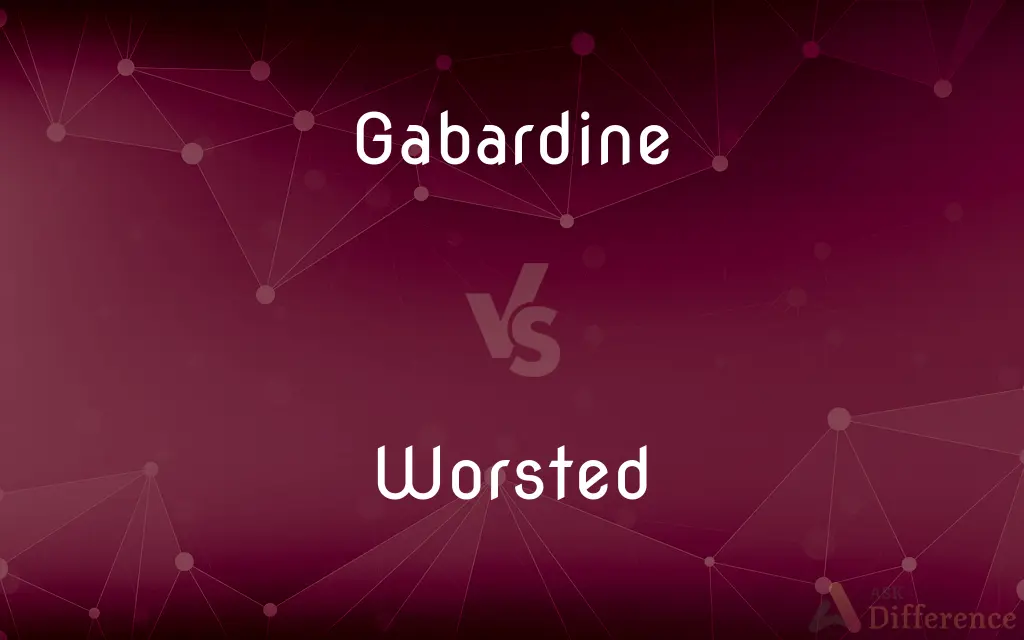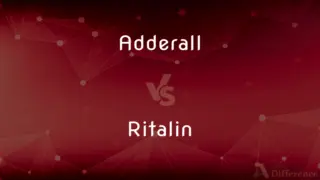Gabardine vs. Worsted — What's the Difference?
By Tayyaba Rehman & Urooj Arif — Updated on April 18, 2024
Gabardine is a tightly woven fabric with a twill weave, known for durability and water resistance, while worsted is a smooth, fine yarn fabric valued for its crisp appearance.

Difference Between Gabardine and Worsted
Table of Contents
ADVERTISEMENT
Key Differences
Gabardine is characterized by its diagonal rib pattern on the face and a smooth back, resulting from a tight twill weave. This structure makes it resistant to wrinkles and weather elements. On the other hand, worsted fabrics are made from finely combed wool, producing a smooth texture and a uniform appearance that’s ideal for formal wear.
Originating from the waterproofing needs in outerwear, gabardine is commonly used for trench coats, uniforms, and other apparel needing durability. Whereas, worsted wool is preferred in business suits, trousers, and fine blazers due to its refined finish and elegant drape.
The production of gabardine involves coating the yarns with a waterproof finish before weaving, enhancing its protective qualities. Conversely, worsted wool is processed through a series of combings that align all the fibers in one direction, lending to its silky, non-bulky feel.
Gabardine’s weight and durability make it suitable for year-round use in temperate climates, particularly in outdoor wear. On the other hand, worsted wool, with its lighter and smoother attributes, is favored in both warm and cool weather, adapting well to various climates.
In terms of care, gabardine is relatively easy to maintain due to its water and dirt resistance, often requiring just regular dry cleaning. Worsted wool, while also durable, can require more frequent cleaning to maintain its crisp appearance and texture.
ADVERTISEMENT
Comparison Chart
Weave
Tight twill weave
Fine, parallel fibers in a smooth weave
Characteristics
Diagonal ribs, durable, water-resistant
Smooth, fine, crisp appearance
Common Uses
Trench coats, uniforms, outdoor clothing
Suits, trousers, formal wear
Fiber Treatment
Coated for waterproofing
Combed to align fibers smoothly
Climate Suitability
Versatile for various climates, especially temperate
Adaptable to warm and cool climates
Compare with Definitions
Gabardine
Often used for protective outerwear.
Gabardine is popular for making durable uniforms and work clothes.
Worsted
Requires careful maintenance.
To keep its smooth texture, worsted clothing often needs to be carefully dry cleaned.
Gabardine
Resistant to wrinkles and elements.
Gabardine pants are ideal for outdoor activities due to their rugged nature.
Worsted
Features a smooth, crisp texture.
Worsted fabrics are favored for formal garments because of their refined finish.
Gabardine
Requires minimal maintenance.
The gabardine fabric can be easily cared for with regular dry cleaning.
Worsted
Lighter than other wool fabrics.
Worsted wool is perfect for both summer suits and winter wear.
Gabardine
Known for its durability and water resistance.
His gabardine raincoat kept him dry during the downpour.
Worsted
Commonly used for elegant and formal apparel.
She wore a worsted skirt to the corporate meeting for a professional look.
Gabardine
A tightly woven fabric with a twill weave.
She chose a gabardine jacket for its durability and classic style.
Worsted
A type of wool fabric made from fine, combed yarn.
His worsted wool suit draped beautifully and looked sharp.
Gabardine
Gabardine is a tough, tightly woven fabric used to make suits, overcoats, trousers, uniforms, windbreakers and other garments.
Worsted
Worsted ( or ) is a high-quality type of wool yarn, the fabric made from this yarn, and a yarn weight category. The name derives from Worstead, a village in the English county of Norfolk.
Gabardine
A sturdy, tightly woven fabric of cotton, wool, or rayon twill. Also called gaberdine.
Worsted
Firm-textured, compactly twisted woolen yarn made from long-staple fibers.
Gabardine
See gaberdine.
Worsted
Fabric made from such yarn.
Gabardine
Chiefly British A laborer's long loose smock; a gaberdine.
Worsted
Natural or synthetic yarn of a medium weight.
Gabardine
A type of woolen cloth with a diagonal ribbed texture on one side.
The merchant found gabardines with finer ribs sold better here.
Worsted
(textiles) Yarn made from long strands of wool.
Gabardine
A similar fabric, made from cotton.
Worsted
The fine, smooth fabric made from such wool yarn.
Gabardine
(countable) A long cloak.
Worsted
Simple past tense and past participle of worst
Gabardine
A yellow robe that Jews in England were compelled to wear in the year 1189 as a mark of distinction.
Worsted
Defeated, overcome.
The army was worsted in battle.
Gabardine
A coarse frock or loose upper garment formerly worn by Jews; a mean dress.
Worsted
Well-twisted yarn spun of long-staple wool which has been combed to lay the fibers parallel, used for carpets, cloth, hosiery, gloves, and the like.
Gabardine
A firm durable fabric with a twill weave
Worsted
Fine and soft woolen yarn, untwisted or lightly twisted, used in knitting and embroidery.
Gabardine
(usually in the plural) trousers
Worsted
A woolen fabric with a hard textured surface and no nap; woven of worsted yarns
Gabardine
A loose coverall (coat or frock) reaching down to the ankles
Worsted
A tightly twisted woolen yarn
Common Curiosities
What are the care instructions for gabardine?
Gabardine should be dry cleaned regularly to maintain its water-resistant properties and appearance.
What is worsted wool best known for?
Worsted wool is best known for its smooth texture and crisp appearance, making it ideal for formal suits and trousers.
Can worsted wool be worn in summer?
Yes, worsted wool is suitable for summer wear due to its fine texture and breathability.
How is gabardine made weather-resistant?
Gabardine is made weather-resistant by coating the yarns with a waterproof finish before weaving.
How does gabardine hold up in rainy weather?
Gabardine holds up well in rainy weather due to its inherent water resistance.
Is gabardine suitable for formal wear?
While gabardine can be used for formal wear like uniforms, it is generally more casual compared to worsted wool garments.
What is gabardine fabric used for?
Gabardine is typically used for making durable clothing like trench coats, uniforms, and other outdoor gear.
Can worsted fabrics be used for everyday clothing?
Yes, while often used for formal wear, worsted fabrics can be tailored into everyday clothing, offering versatility and comfort.
Why is worsted wool considered high-quality?
Its processing includes combing the fibers to align them, which enhances the fabric’s smoothness and durability.
What makes worsted wool different from other types of wool?
Worsted wool differs in that the fibers are combed before spinning, producing a smoother, finer fabric.
How does the weight of gabardine compare to worsted?
Gabardine is generally heavier and more substantial than worsted, making it ideal for outerwear.
What are the environmental considerations for both fabrics?
Both fabrics should be sourced responsibly, with worsted wool often having higher environmental impacts due to wool production processes.
Which fabric is better for professional settings?
Worsted wool is typically preferred in professional settings due to its elegant appearance and fine texture.
How do fashion designers use gabardine and worsted?
Designers use gabardine for durable, functional pieces, while worsted is chosen for refined, high-end clothing.
Are there synthetic versions of gabardine or worsted?
Synthetic versions of both fabrics exist, offering alternatives in cost and care properties.
Share Your Discovery

Previous Comparison
Dubbed vs. Subbed
Next Comparison
Adderall vs. RitalinAuthor Spotlight
Written by
Tayyaba RehmanTayyaba Rehman is a distinguished writer, currently serving as a primary contributor to askdifference.com. As a researcher in semantics and etymology, Tayyaba's passion for the complexity of languages and their distinctions has found a perfect home on the platform. Tayyaba delves into the intricacies of language, distinguishing between commonly confused words and phrases, thereby providing clarity for readers worldwide.
Co-written by
Urooj ArifUrooj is a skilled content writer at Ask Difference, known for her exceptional ability to simplify complex topics into engaging and informative content. With a passion for research and a flair for clear, concise writing, she consistently delivers articles that resonate with our diverse audience.















































